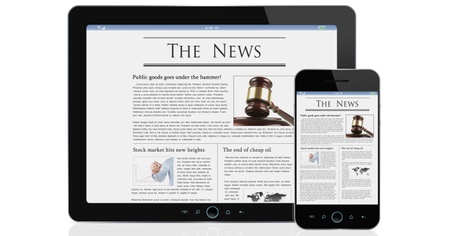Originally published on June 5, 2012 in our free BigLaw newsletter. Instead of reading BigLaw here after the fact, sign up now to receive future issues in realtime.
According to Law Firm Mobile, only 19% of AmLaw 200 law firms have mobile-friendly web sites. Most of your clients now have smartphones so it's time to get started on a mobile web site. Fortunately, iPhone for lawyers expert Jeff Richardson is a partner at Adams and Reese, one of the 19% with a mobile web site. In this issue of BigLaw, Jeff offers five tips based on his firm's experience creating its mobile web site. His tips encompass design, content, and new technologies such as media queries. As an added bonus, Jeff also discusses whether your firm also needs a smartphone app in addition to a mobile web site. Also, don't miss the BigLaw Pick of the Week (newsletter only) for an article that analyzes several prominent law firms, all of which explain why they're not the next Dewey.
FIVE TIPS FOR CREATING YOUR LAW FIRM'S MOBILE WEB SITE

In 1995, I was one of the attorneys at my law firm responsible for creating our first web site. Few large law firms even had web sites. Netscape Navigator 1.0, the first commercial web browser, was just a few months old at the time so these were early days. However, we knew then that the Internet was here to stay so we wanted to make it easy for current and potential clients using this new medium to learn about our firm and its attorneys.
We wanted our web site accessible to all, so we made sure that the main page would look good on a VGA monitor with dimensions of 640 x 480 pixels. (By comparison, today a typical 24 inch display has 1920 x 1200 pixels.) We also included a link to a text-only version of the web site since some of our clients were using used text-only web browsers like Lynx. Even those with Netscape Navigator might prefer fast text versus images that took time to download over slow dialup connections.
Today, all large law firms have a web site, most of which are designed to take advantage of a large monitor and which feature graphics, photos, videos, and other rich media. Meanwhile, many clients use devices such as iPhones or iPads that have smaller screens and cannot handle some of the technologies such as Flash used on "modern" web sites.
The solution to this changing behavior is to create a mobile version of your web site. Just as most large firms didn't have a web site at all in 1995, most large law firms today lack a mobile web site. Law Firm Mobile looked at AmLaw 200 web sites a few months ago, and found that only 37 (19%) had a version formatted for mobile devices.
Accessibility remains central to our firm's philosophy about our web site. Accordingly, we created a mobile version of our web site in 2011. Based on that experience and what I've seen elsewhere, this issue of BigLaw contains five tips for making your law firm web site mobile-friendly.
1. Small but Well-Designed
Obviously, you want a professional-looking layout that fits a small smartphone screen. The iPhone 3GS (like earlier iPhone models) has a 480 x 320 pixel screen. That is a good target size.
More current smartphones such as the iPhone 4S have larger pixel ratios (e.g., 960 x 640), but rather than display more information they display the same information at a higher pixel density (the iPhone's retina display has 326 pixels per inch). Therefore, a mobile site designed with 480 x 320 pixels as a baseline will look good on more modern smartphones too.
One caveat however. Make sure your graphic designer understands how to prep photos and other graphics so that they will look sharp rather than fuzzy on smartphones that have a high pixel density.
Using the free Wayback Machine, you can see old versions of many web sites, including law firm web sites created in the 1990s. Many of the same design philosophies used to create web sites over 15 years ago are once again useful today when designing a version of your law firm web site that looks great on a mobile device (except for the graphics as noted above).
2. Keep It Simple and Make Key Information Easily Accessible
Clients typically won't access your web site from an iPhone to learn everything about your firm. Focus on the key items they will likely want to find on the go, especially attorney profiles with phone numbers and email addresses plus the addresses of each of your firm's locations.
Clients meeting a lawyer for the first time may use a mobile device to see what they look like, so include a photograph with each bio that either scales without getting blurry when zoomed (see above) or links to a larger version.
The home page of your mobile web site should contain obvious links to these key items. If you want to also include news, practice areas, etc. that's fine but don't let it get in the way of the simple information people are most likely to seek from a mobile device.
3. Keep the Information Updated, Preferably Automatically
Ideally, you want to use the same database (content management system) so that as information changes on your main web site, it changes on the mobile site at the same time.
4. Link to the Full Website and Don't Use Plugins
Sometimes a client might want to access the full version of your web site even on a small mobile device. Give the client the option to click a link to view the full web site.
Also, if you can avoid the use of Adobe Flash and other plugins that don't work on mobile devices, you should do so. If not, provide an alternative way to see the same information.
For example, have you ever tried to access a restaurant web site from your iPhone, only to discover the that web site is created entirely in Adobe Flash? This is frustrating when you want to see a menu or make a reservation — so much so that you might just pick a different restaurant. Don't frustrate existing or prospective clients.
5. Better Yet, Use Media Queries
The previous section discusses the importance of enabling people to access your entire site. The mobile web design world evolves fast. While too late for our firm, you should explore a new technology called media queries or responsive web design, which enables you to create a single web site that automatically adjusts depending on the width of the web browser.
In other words, you don't create a separate mobile site, but instead different styles for different widths (typically 3-5 styles). The advantage is that the URL of each page on your site is the same so if someone bookmarks a page on their iPhone and then views it on their PC later they will not see the mobile version but the full site. The Boston Globe uses media queries. You can find many examples on a site aptly named Media Queries.
For further reading on this topic:
Kayla Knight, Responsive Web Design: What It Is and How To Use It, Smashing Magazine, January 12, 2011
Google, Responsive Design: Harnessing the Power of Media Queries, April 30, 2012
Ethan Marcotte, Responsive Web Design (2011)
What About an App?
Apple loves to tell us that "there's an app for that," but your law firm probably doesn't need an app. Law Firm Mobile recently reported that only 16 of the AmLaw 200 firms have mobile apps. Nobody loves iPhone apps more than me, but I see little need to increase that number.
Developing a quality app and keeping it updated requires time and money. So will your mobile web site. You need to answer the question of why an existing or potential client would bother to download your law firm app instead of just using your mobile web site. One possible answer is to access information on a plane or elsewhere without Internet access, but how common a use case is that? Also, creating an app that works offline increases its costs.
If you must have an app, consider offering something different from your web site that a client would find useful. For example, Latham & Watkins produced three free "The Book of Jargon" apps that include definitions of business terms used in European capital markets and bank finance, project finance, and corporate and bank finance. Read my review on iPhone J.D.
These apps are useful so clients have a reason to download them, plus they demonstrate to potential clients that the firm understands these areas of law.
How to Receive BigLaw
Large and midsize law firms have achieved unprecedented success yet they still have tremendous growth potential. Written by insiders, corporate counsel, and other industry experts, BigLaw unearths best practices in leadership, marketing, strategy, and technology, and features detailed product reviews with accompanying TechnoScore ratings. BigLaw also ensures that you won't miss anything published elsewhere by linking to insightful articles (and podcasts and videos) about large and midsize law firms, as well as notable press releases issued by the world's largest law firms. The BigLaw newsletter is free so don't miss the next issue. Please subscribe now.













